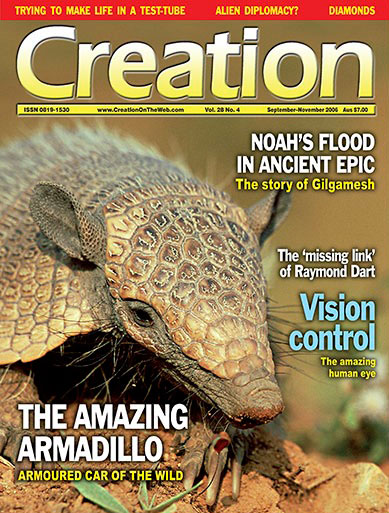Colourful creature coats
Animals display a wide variety of coat colours. These colours result from a pigment called melanin. There are two types of melanin: one that results in a yellow-to-red colour (pheomelanin) and another that results in a brown-to-black colour (eumelanin). Most animals can produce both, and a number of different genes (instructions found in DNA) regulate the relative amounts of these two forms of melanin and their distribution.
 |
 |
 |
 |
 |
 |
 |
 |
 |
Sometimes genes can be changed by a process known as a mutation. A mutation is basically a mistake in copying a gene and results in a new allele (variant form of the gene). How it affects the animal depends on where it occurs. Mutations that occur in one specific gene have interesting effects on animal coat colour.1 This gene codes for a protein that works like a switch.2 Normally, a hormone3 switches it ‘on’ to produce more of the darker eumelanin, while another protein4 switches it ‘off’ so more pheomelanin is produced.

One type of mutation messes up the switch. In this case the animal cannot produce eumelanin, even when it is signalled to do so. The yellow/red colour of Golden Retrievers, Yellow Labradors, and Irish Setters results from one such mutation.5 A different mutation with a similar effect causes the chestnut colour in horses. A number of other animals have this type of mutation as well. These are called loss-of-function mutations because the animals lose the ability to produce eumelanin. They are usually recessive, meaning that if the other of the pair of alleles is the normal type, the mutant allele has no effect; it is hidden. This means that animals with light coat colour must have a gene pair of two mutant alleles, one being inherited from each parent. If one of the alleles is the normal form, the colour will be normal, not light.
A second type of mutation in this same gene results in pigment production that is always switched on. In this case the production of eumelanin is ongoing, regardless of the signals being received. This type of mutation has been found in cattle, sheep, mice, and chickens.6 It is sometimes called a ‘gain-of-function’ mutation7 because the animal produces more eumelanin than it would normally, resulting in very dark / black colouring. However, this term is misleading because the animal has lost its ability to control eumelanin production. These mutations are typically ‘dominant’; only one mutant allele is necessary for the animal to be affected.

Since this gene affects only the colour of an animal, mutations in it are well tolerated,8 meaning that it does not affect the animal’s ability to survive. Therefore, it is no surprise to find that dozens of different alleles have been found for this gene.9 These mutations are all downward changes, where a complex pathway has been disrupted. None are examples of onward, upward change that evolutionists imagine have occurred throughout history. What we see fits the Bible’s history where an all-wise Creator made everything very good (Genesis 1, 2) and these downward changes in the well-designed biochemical pathways of living things began after mankind rebelled against God (Genesis 3).
While the mutations discussed here may be well tolerated, thousands of others result in disease. They remind us of the fallenness of the creation, where everything is now ‘in bondage to decay’ (Romans 8:19–23). But Jesus, the Son of God came ‘to reconcile to himself all things, whether on earth or in heaven’, so all who are ‘in Christ’ (Romans 8:1) can look forward to a new heavens and earth where there will be no more sickness, suffering and death (Revelation 21:4), because the Curse will be removed (Revelation 22:3).
References and notes
- This is referred to as the extension (E) locus. Return to text.
- Specifically, this protein is the melanocortin 1 receptor which is found in the cell membrane of cells that produce pigment (melanocytes). Return to text.
- I.e. melanocyte stimulating hormone (MSH). A hormone is a substance made by one type of cell that affects other cells in a different part of the body. Return to text.
- I.e. the agouti protein, coded for at the agouti (A) locus. Return to text.
- Newton, J.M., Wilkie, A.L., He, L., Jordan, S.A., Metallinos, D.L., Holmes, N.G., Jackson, I.J., Barsh, G.S., Melanocortin 1 receptor variation in the domestic dog, Mamm. Genome 11(1):24–30, 2000. Return to text.
- Klungland, H. and Våge, D.I., Molecular genetics of pigmentation in domestic animals, Curr. Genomics 1(3):223–242, 2000. Return to text.
- Vassart, G., TSH Receptor mutations and diseases, thyroidmanager.org. Return to text.
- In humans, loss of function mutations in this gene are associated with red hair, pale skin, inability to tan well in response to sun exposure, and an increased risk of skin cancer. Rees, J.L., The genetics of sun sensitivity in humans, Am. J. Hum. Genet. 75(5):739–751, 2004. Return to text.
- If a mutation causes premature death in an animal, the animal isn’t as likely to have offspring and pass the mutation on. When a mutation doesn’t cause significant problems, it can persist in a population. With coat colour, animal breeders have selected some of these mutations because people like the colours. Return to text.
(Article is also available in Urdu)
Re-posted on homepage: 12 April 2017




Readers’ comments
Comments are automatically closed 14 days after publication.